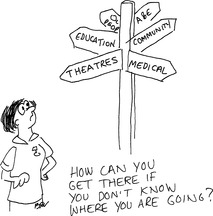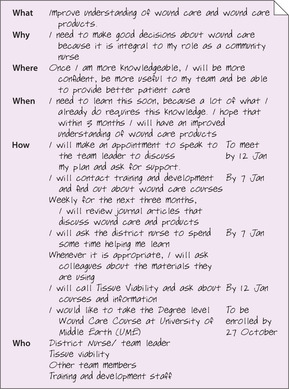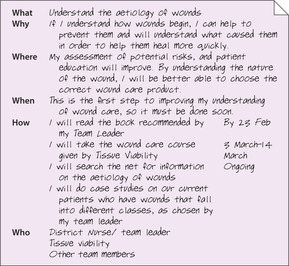• Summary
 |
This chapter looks at your own personal and professional development. You will need to continue to prove over the course of your career that you have maintained your knowledge and competencies. You will also want to have a plan for growing into the kind of nurse you want to be. If you don’t plan, you won’t be ready when the opportunities you would like come up!
PERSONAL DEVELOPMENT PLANS
Personal development plans (PDPs) help you identify and carry out development that you will need. The areas of development can be very diverse. You might want to develop in any of a number of areas, for example by:
• developing a new clinical skill
• developing knowledge of a disease or medical problem
• developing more assertiveness
• taking a certain specialty course
• gaining better IT skills.
All of these things would be related to your practice as a nurse. The beauty of planning is that you can choose the areas you want to develop. As you probably have guessed, PDP and reflection are closely linked. As you reflect, you start to see what you need for development. The PDP then helps you work out how you are going to develop.
Some other areas that might drive your development planning are government initiatives and policies, which are:
• The National Service Frameworks, which require practitioners to give a certain level of care.
• Essence of Care, which outlines certain standards.
• The Department of Health, which puts out bulletins making recommendations about care and practice.
• The Knowledge and Skills Framework under Agenda for Change.
The professional press (books and journals) can also help you become aware of areas where you need to develop. For example, you might have read an article about catheter care in the Nursing Standard or Nursing Times, and it made you realise that you don’t have a good understanding of suprapubic catheterisations. You have recognised that this is a development need, as you care for patients with catheters.
In addition, there are national nursing forums, specialty nursing groups and organisations such as the Royal College of Nursing that will put out material designed to help you recognise gaps and advance your practice.
All of these things – reflection, policy, your employer, books and journals, and organisations – can give you ideas about how to develop your practice. They can also help you to develop that practice once you know what you want to do. But in order to get there, you need a plan.
The plan starts by you looking inward and taking an inventory of what you already know, what you can build on, what is weak and what you think you need.
Let’s use Oliver as an example:
Oliver Thorpe is a new staff nurse on a ward for older people. He wants to become a clinical nurse specialist in a couple of years and perhaps do a Master’s degree in advanced practice. He has done some reading and observed the skills his more experienced colleagues have. He sits down and makes a list of things he needs.
I need to learn about:
1. wound care – I don’t know what half the dressings do, or when to use them!
2. leg ulcer diagnosis and care
3. community assessment in general
4. making referrals
5. evidence-based practice, research and audit.
1. I need to be more assertive.
2. I need to improve my time management skills.
3. I need to learn more about the documentation used by my team.
Finally, Oliver knows from his team leader that he will be expected to use a new form:
1. I need to learn more about the single assessment process and SAP forms.
As a new nurse, Oliver has identified nine areas in which he wants to develop himself and his practice. He decides to focus on just one area for now: wound care. Remember the nursing process (assess, plan, implement/intervention, evaluation) mentioned in Chapter 2? In the same way, Oliver has done his assessment and moves on to his plan.
The first step of the plan is actually a transition between your assessment and your plan. In the initial stage, you are looking more in-depth at each of your assessed needs. It has two real purposes: to help keep you motivated because you really understand why you need this level of development, and to help you think out what you need to do to achieve goals.
Your initial plan should be based on a basic formula:
What? Why? Where? When? How? and Who?
• What do I need to learn or do? What do I need for funding?
• Why is it important for me to do this?
• Where will I be once I have done this?
• When are the classes/in-service training held? How soon do I need to do this?
• How will I accomplish this and how much time will I need? (including a timeline for actions)
• Who can help me to achieve this? Who might pay for this course/in-service training?
Looking at his development needs for ‘wound care’, Oliver makes the following plan:
|
For each of these, he develops another plan:
|
One thing Oliver notices is that there isn’t a lot of information available on wound care and wound-care products in the team’s office, so he starts to build a team resource folder as he finds information for himself.
After he has taken the wound-care course, Oliver realises that his team could use an audit of the patients’ wounds and the wound-care products being used. He asks his team leader for help and together they design an audit tool. He brings it to a team meeting and asks everyone to use it.
Once he has all the information for the audit, Oliver and his team leader look at the findings. He finds that although most nurses use products in the way suggested by Tissue Viability (as specified in the policies given out in the wound-care course), in a few cases the dressings used don’t seem to make sense. The team leader reviews these cases and decides that a team update on wound care would be useful. Oliver is asked to prepare a brief presentation on his audit and the team leader offers help so that Oliver can do a presentation on what the results mean for the team.
As part of his evaluation, Oliver put all his reflections, the certificate from the Tissue Viability course and the audit results in his PREP and KSF portfolios. He also looks back at the list of things he wanted to learn:




1. wound care – I don’t know what half the dressings do, or when to use them!
Stay updated, free articles. Join our Telegram channel

Full access? Get Clinical Tree


Get Clinical Tree app for offline access


